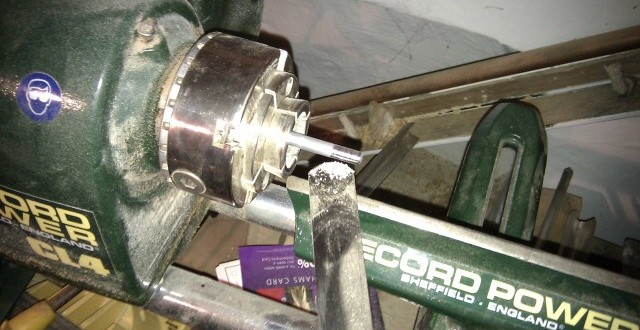Of all the parts of this project the one that probably caused me the most trouble was the tensioning and tracking system. It’s not strictly necessary for the two features to be built as one piece, you could tension the drive wheel and track the idle wheel but I felt it made sense for them to be built as one component. The system that I settled on is built around springs running along pieces bar held in place with shaft collars – my inspiration for this comes from a Lego Technic Car I built many many years ago as a kid but the basic idea is very common.
I cut a couple of pieces of 8mm bar to length and drilled some holes in the case. Much to my disappointment I discovered that the bar didn’t fit in the 8mm holes I’d drilled. Thinking I’d probably picked up the wrong drill bit I went to test fit one of the shaft collars which, wait for it, also didn’t fit. Out came the calipers and lo and behold I discover that the bar is actually about 8.1mm but varies from 7.96 to 8.15. A quick calculation shows that this is actually an error in diameter of <2% but that 2% was enough for me to not be able to fit the bar in any standard hole I was going to be making. Worse though I went to fit one of the springs and it wasn’t even close to sliding onto the bar – in fairness though I had to guess a bit with the springs.
So, I was faced with a problem. Do I try and make the bar smaller the springs, holes and collar larger? Since I couldn’t think of a way of making the springs larger without wrecking them I decided to make the bar smaller even though I have no metal working facilities. I started off with a bit of 80 grit sandpaper and some elbow grease. I managed to reduce the diameter of the first 20 or 30mm of the bar enough to get the collar on but I still couldn’t get the spring on. Clearly I needed to get a machine on the scene. Although I’ve never done any metal work I realize it’s not a million miles away from woodwork and I have a decent variable speed woodworking lathe so I mounted the bar in that and fired it up at a very slow speed. An hour or so and a lot of sanding later I had a bar that slid into the holes in the case and accepted the collar. The spring also just about fitted but it was a little tighter than I would have liked.
Sanding the bar down to diameter was boring and slow work and didn’t give a very good finish so I decided to sleep on the problem. Next morning I got up and decided I’d try my hand at some metal turning. I knew that most metal working bits are just HSS which is what my turning tools are made from so I figured they should be able to cut the aluminium. From watching a couple of videos I also deduced that metal turning is achieved via scraping rather than cutting so I got my one wood turning scraper out (a half round), suited up in every bit of protective gear I own and set at it. My fear was that with the metal being so hard compared to wood any catch or dig in would most likely result in very bad things happening. Being very hard the metal would also need just the lightest of touches to prevent a catch.
To cut a long story short I needn’t have worried. Turning the aluminium bar was very easy using the burr on the back of the scraper. By the end of the second bar I was able to produce quite long pieces of swarf. In fact I had become so confident that I turned half rounds on the ends of the bars to that they wouldn’t cut into the idler stock.
The photo below shows the basic arrangement for the tensioning system. The design allows for up to three tensioning bars to be fitted although I have only two shaft collars at the moment. The tensioning bar is slid through the case from the idler side while a collar, spring and 8mm washer are fitted. Once pushed all the way through the collar is tightened down so that when the bar is pushed from the idler side it compresses the spring. The washer is simply to stop the spring slipping in to or catching on hole in the MDF.
This photo shows the tensioning system with both tensioners fitted. It’s just about possible to fit the bottom tensioner with the top one in place. The springs allow for about 30mm of travel (unfortunately the springs are very slightly compressed when at rest – they were a little longer than I expected). If under full compression it’s not possible to get the belt on it’s simple to slacken of the collars and slide the bar a little further through and try again. I have mine set so that the springs are at about 90% compression when the belt is fitted.



